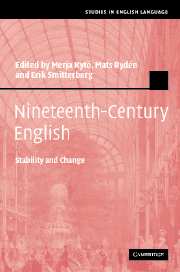Book contents
- Frontmatter
- Contents
- List of plates
- List of figures
- List of tables
- List of contributors
- Acknowledgements
- Introduction: Exploring nineteenth-century English – past and present perspectives
- 1 Modifiers describing women and men in nineteenth-century English
- 2 Words in English Record Office documents of the early 1800s
- 3 The subjunctive in adverbial clauses in nineteenth-century English
- 4 The passive in nineteenth-century scientific writing
- 5 Relativizers in nineteenth-century English
- 6 Anaphoric reference in the nineteenth century: that/those + of constructions
- 7 Adjective comparison in nineteenth-century English
- 8 Nonfinite complement clauses in the nineteenth century: the case of remember
- 9 The in -ing construction in British English, 1800–2000
- 10 Partitive constructions in nineteenth-century English
- Appendix
- References
- Name index
- Subject index
6 - Anaphoric reference in the nineteenth century: that/those + of constructions
Published online by Cambridge University Press: 22 September 2009
- Frontmatter
- Contents
- List of plates
- List of figures
- List of tables
- List of contributors
- Acknowledgements
- Introduction: Exploring nineteenth-century English – past and present perspectives
- 1 Modifiers describing women and men in nineteenth-century English
- 2 Words in English Record Office documents of the early 1800s
- 3 The subjunctive in adverbial clauses in nineteenth-century English
- 4 The passive in nineteenth-century scientific writing
- 5 Relativizers in nineteenth-century English
- 6 Anaphoric reference in the nineteenth century: that/those + of constructions
- 7 Adjective comparison in nineteenth-century English
- 8 Nonfinite complement clauses in the nineteenth century: the case of remember
- 9 The in -ing construction in British English, 1800–2000
- 10 Partitive constructions in nineteenth-century English
- Appendix
- References
- Name index
- Subject index
Summary
Introduction
The anaphoric pronouns that/those in connection with a following of-phrase suggest a notable degree of formality to many native speakers of English. It has been observed that in relation to corresponding genitival constructions, the use of the of construction in general is thus also more common in those genres usually associated with a greater level of formality. This tendency has been seen in texts from earlier centuries (for instance, in seventeenth-century texts, see Altenberg 1982: 251–5). The comparatively even more formal nature of the combined that of/those of constructions is evident in the present day, and has been noted by several authors (e.g. Schibsbye 1970: 118; Perttunen 1986: 168; Biber et al. 1999: 307). Comparing expressions as regards their differing shades of formality, Perttunen (1986: 168) considers constructions with that of and those of ‘very formal’. In a similar vein, Biber et al. (1999: 307–8) argue that these constructions are ‘felt as overwhelmingly associated with careful expository writing and hence inappropriate to conversation’, and thus the notion of formality in this chapter is to be determined extralinguistically, i.e. depending on the situation of communication.
A typical instance of anaphoric that/those followed by an of-phrase can be seen in the following sentence, culled from CONCE (= A Corpus of Nineteenth-century English; see the Introduction to this volume):
(1) To the outward observer, Lawrence's situation was almost as difficult as that of his brother at Lucknow.
(History, Spencer Walpole, 1870–1900, p. VI, 310)- Type
- Chapter
- Information
- Nineteenth-Century EnglishStability and Change, pp. 183 - 193Publisher: Cambridge University PressPrint publication year: 2006

